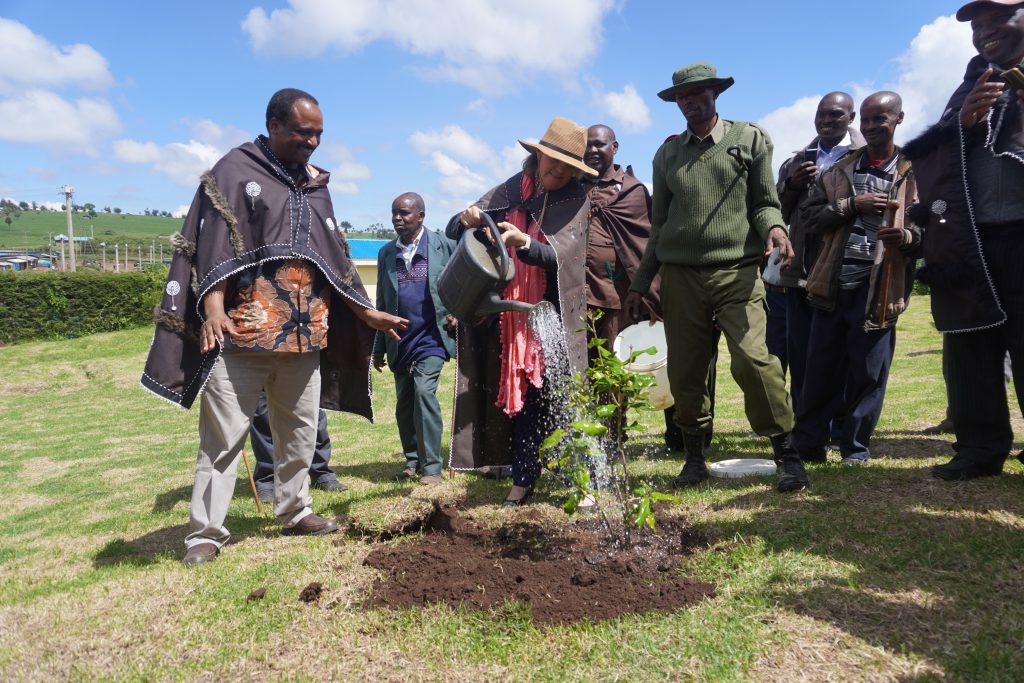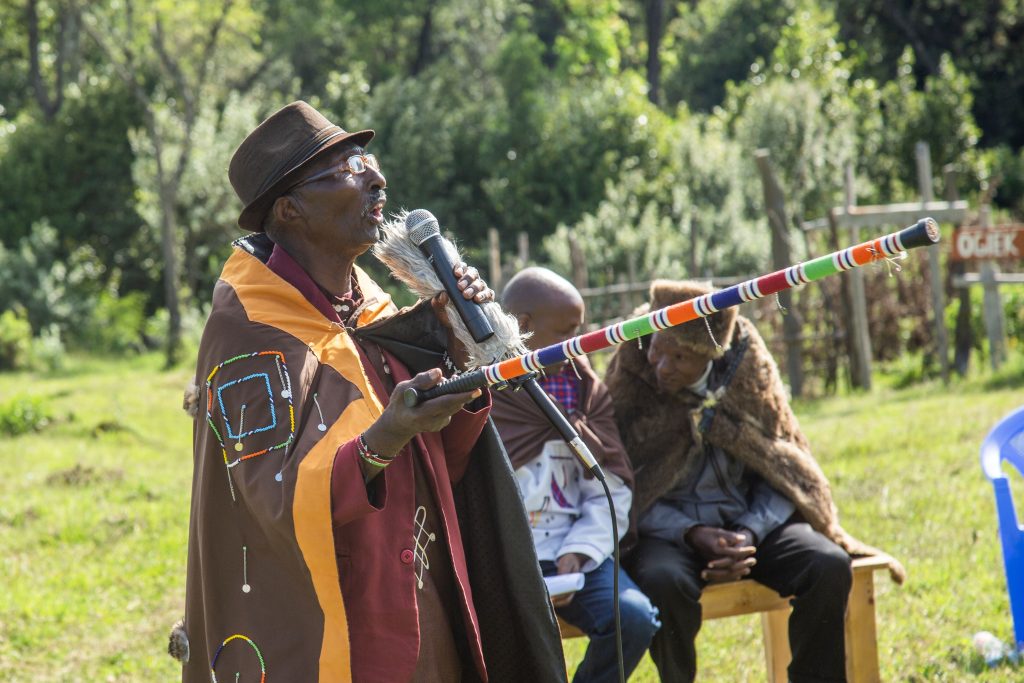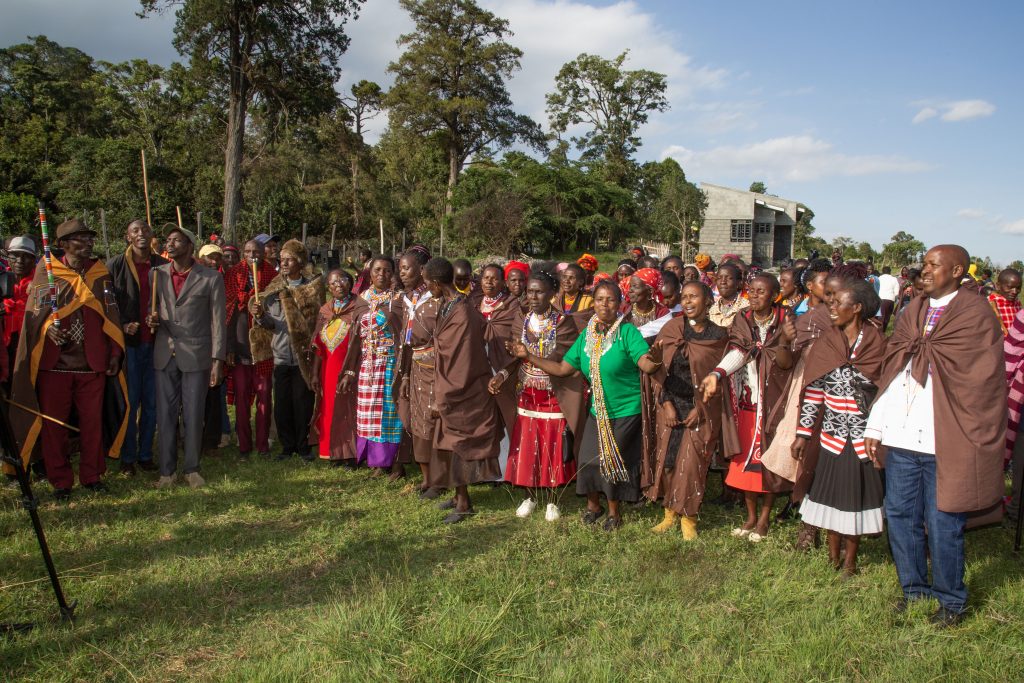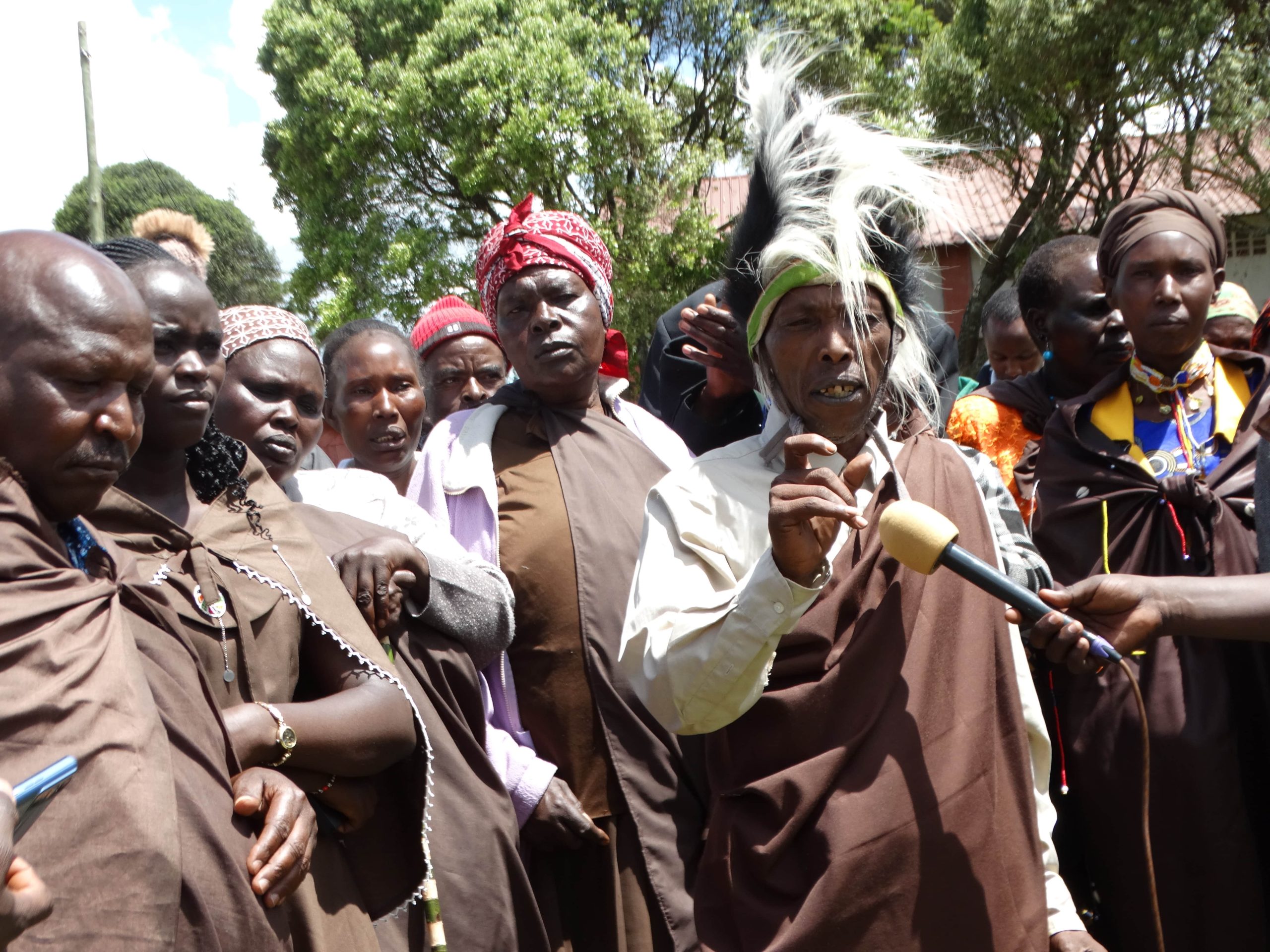Six years ago; May 26th, 2017, the Ogiek community achieved a historic legal victory when the African Court on Human and Peoples’ Rights recognized their rights to their ancestral lands in Kenya’s Mau Forest Complex. This ruling affirmed their status as Indigenous Peoples[1] and their role as custodians of the Mau ecosystem. On May 26th, 2023, the Ogiek community marked the 6th years of this milestone with joy and determination in Nakuru, Uasin Gishu and Narok Counties. They urged the government to speed up the implementation of the court judgments to ensure their full justice and equality.
Ogiek Peoples’ Development Program (OPDP) seized the opportunity to raise awareness about the reparations judgment that took place on June 23rd, 2022. The community was sensitized on the orders given by the African Court, outlining crucial measures to be implemented by the government. These orders aimed to rectify past injustices and secure the Ogiek’s rights to their ancestral lands, cultural practices, and recognition as Indigenous Peoples. ODPD also highlighted actions pushing for the implementation of the African Courts’ decisions that have been taken with leadership from the Ogiek Council of Elders and with guidance from the Committee of External Experts (comprising of Ogiek legal team, land experts, human rights activists, development partners and OPDP management). The community also learnt that a 15-members Supervisory Board made up of community members across the 6 chapters; women and youths representation has also been formed. This is tasked to lead in the push for implementation and would be reporting to the Ogiek Council Elders.
A Joyful Celebration

The Ogiek community came together in a display of unity and pride to commemorate the 6th anniversary of the landmark ruling. They expressed their gratitude and happiness through traditional songs and dances, showcasing their rich cultural heritage and their deep connection to the land. The event was also attended by dedicated development partners who supported the Ogiek’s cause and celebrated their achievements. In Nakuru County, over 600 hundred of community members gathered in Mariashoni Centre where they were led in the celebration by OPDP’s Founder and Executive Director Mr Daniel Kobei who was accompanied by development partners and representatives from the media fraternity.
In his address, Kobei urged the community to fiercely protect their ancestral lands through planting trees and protecting the existing biodiversity. He reminded them to remain united and not to lose hope in the struggle to return home. “As we stand here today, united in our pursuit of our land rights, let us carry within us the strength and resilience of our ancestors. Let their spirits guide us as we navigate the challenges ahead. Together, we can overcome any obstacles that comes our way. Let us continue to work hand in hand, building bridges of understanding and collaboration with government agencies, development partners, and all stakeholders involved. I have faith in our collective power and unwavering determination. We shall see the day when the rights of the Ogiek community are fully recognized and respected. When our forests thrive, our culture flourishes, and our people thrive in harmony with nature.” Kobei urged the celebrants.
In Narok County, over 200 community members gathered at the Ogiek Cultural Centre in Nkareta to mark the 6th anniversary. The community took this event to celebrate their culture and to urge each other to remain united in the journey towards land rights. Speaking with his fellow community members, Ogiek Council of Elders Chairman, Narok Chapter Mr Wilson Memusi, invited the Ogiek to recommit themselves to the land rights struggle until every Ogiek enjoys secure land rights. “Let us recommit ourselves to the cause. Let us walk forward with hope in our hearts, fuelled by the knowledge that justice will prevail and our voices will be heard. Together, we will create a future where our children and grandchildren can proudly embrace their Ogiek heritage, knowing that we have left them a legacy of resilience, unity, and love for our land.” Memusi urged the Ogiek gathered in Nkareta.
In Uasin Gishu County, over 250 Ogiek community members gathered in Ndungulu area. They called upon the Kenyan government to respect the African Court by implementing the Court’s decision immediately. Speaking during the event, Arap Sang who is the Chairman of the Ogiek Council of Elders, Uasin Gishu Chapter said, “I implore you to refrain from engaging in activities that go against the African Court’s ruling on our case. Some community members have been swayed by misleading entities claiming to represent the Ogiek community. These individuals are misusing our name and distorting the judgments made by the African Court to serve their personal agendas. I sincerely request you, my dear friends, to dissociate yourselves from such individuals. Let us have one voice and one agenda, to return home together.”
African Court’s judgements in brief

The judgment by the African Court on May 26th, 2017 was a significant legal victory for the Ogiek community and for all Indigenous Peoples. It recognized the Ogiek’s rights to their ancestral lands in the Mau Forest, which had been threatened by evictions, logging, and conservation projects for decades. It also validated their identity as Indigenous Peoples and their contribution to environmental protection. The African Court ordered the government to take measures to repair the harm done to the Ogiek and to protect their lands from further encroachment.
The reparations judgment by the African Court on June 23rd, 2022 ordered the Kenyan government to pay monetary compensation to the Ogiek community, grant them collective land title and legal recognition as an indigenous people, respect their rights to consultation and non-repetition of violations, and establish a fund and a committee for their development. The ruling also required the government to publish the judgments in official and public media, and report on the implementation status within 12 months. The court would then hold a hearing on implementation after 12 months.
A Call for Action
While celebrating the progress made, the Ogiek community and their development partners also used the occasion to call upon the government to expedite the implementation of the African Court’s judgments. They stressed that the government had not done enough to comply with the Court’s orders and that the Ogiek still faced challenges in securing their land rights and recognition. They appealed to the government to prioritize the fulfilment of its obligations and to respect the Ogiek’s rights as Indigenous Peoples.
Creating Awareness on reparation judgment

The event also served as an opportunity for OPDP, to create awareness among the Ogiek community about the reparations ruling that took place on June 23rd, 20223. They sensitized the community on the orders given by the African Court. This awareness-raising effort aimed to empower the Ogiek community by ensuring they understood their rights and the actions required for their fulfilment the African Court’s decisions.
The African Court’s reparations ruling contained a series of essential orders, designed to rectify historical injustices and protect the Ogiek community’s rights. These orders included:
Pecuniary Reparations: The Ogiek Community was awarded Kenya Shillings 157,850,000, with Kenyan Shillings 57,850,000 designated for material prejudice and Kenyan Shillings 100,000,000 for moral prejudice.
Granting of Collective Land Title: The government was directed to take all necessary measures, both legislative and administrative, to identify, delimit, and grant collective land title to the Ogiek community. This would ensure their unhindered use and enjoyment of their ancestral lands.
Dialogues and Land Return: Where concessions or leases have been granted to third parties, the government was instructed to initiate dialogues between the Ogiek community, the government, and the third parties. The aim was to reach agreements regarding the continued presence of third parties on the land, including the payment of rents or royalties and profit-sharing with the community. If agreements couldn’t be reached, the government was mandated to return such land to the Ogiek community.
Legal Recognition: Within one year, the government was required to take all appropriate measures to grant full legal recognition to the Ogiek community as Indigenous Peoples. This recognition encompassed their language, cultural practices, and religious rights.
Consultation on Developments: The rights of the Ogiek community to be consulted in all developments or projects on their ancestral land were to be recognized and respected by the government.
Non-Repetition Guarantee: The government was obligated to take all necessary measures to give full effect to the court’s judgment as a means of guaranteeing non-repetition of past injustices.
Community Development Fund: Within 12 months, the establishment of a Community Development Fund was to be initiated, with all ordered funds being deposited into it.
Committee Formation: Within 12 months, a committee for the management of the ordered funds was to be established and operationalized, ensuring full consultation with the Ogiek community.
Implementation and Reporting: The government was required to publish official summaries of the Reparations Judgment and the previous Merits Judgment in the official Gazette and an English-language newspaper with wide national circulation. The full text of the judgments was also to be published on an official government website for at least one year.
Monitoring and Reporting: Within 12 months, all parties involved were mandated to submit a report to the court on the status of implementation of the orders.
The awareness created within the Ogiek community about the reparations ruling and its orders has injected renewed momentum into the pursuit of justice and land rights. The community stands united, urging the government to swiftly implement the court’s orders, ensuring the restoration of their rights, dignity, and autonomy. The commitment of the Ogiek community, along with the support of development partners, reinforces their determination to secure justice, safeguard their ancestral lands, and protect their cultural heritage.
A United Front
The Ogiek community stood as a united front, sending a powerful message of resilience and determination. They reaffirmed their commitment to safeguarding their ancestral lands and heritage, which hold immeasurable value for both present and future generations. They also expressed their solidarity with other Indigenous Peoples across the world who are facing similar struggles for land rights and recognition. The event highlighted the strength of their collective voice and their vision for justice.
Looking Ahead
The Ogiek community continues its journey towards justice and land rights with hope and courage. The 6th anniversary celebration was a testament to their spirit, resilience, and achievements. With dedicated development partners by their side, including OPDP, which has been working with them since 1999, the Ogiek community remains hopeful that their calls for action will be heard, and that their rightful place as custodians of the land will be fully acknowledged and respected.
Conclusion1012691129.
The 6th anniversary of the landmark ruling by the African Court on Human and Peoples’ Rights was a significant occasion for the Ogiek community. It symbolized their legal victory, their cultural identity, and their environmental stewardship. Through unity, celebration, and awareness creation, the Ogiek community and their development partners called upon the government to speed up the implementation of the court judgments. The event showcased their resolve to protect their ancestral lands and heritage, which resonates as an inspiration to all those who champion the rights of Indigenous Peoples around the world.
[1] This declaration is based on The United Nations Declaration on the Rights of Indigenous Peoples (UNDRIP) which provides a comprehensive definition of Indigenous peoples. According to Article 1 of UNDRIP. Defining Indigenous People as are distinct collective ethnic groups who are the descendants of the original inhabitants of territories now governed by states, and who retain some or all of their own social, economic, cultural, and political institutions. Further reading; United Nations. (2007). United Nations Declaration on the Rights of Indigenous Peoples. Retrieved from https://www.un.org/development/desa/indigenouspeoples/wp-content/uploads/sites/19/2018/11/UNDRIP_E_web.pdf
